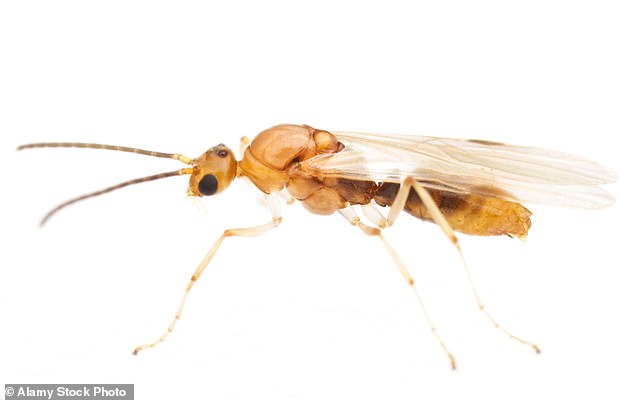Officials are sounding the alarm as venomous Asian needle ants are invading more parts of the US.
These insects, native to China, have a sting that can trigger severe allergic reactions, and in extreme cases, death.
This invasive species was first spotted in the US more than 90 years ago, but its population has recently surged and is now spreading up the East Coast, experts say.
They are now found in 19 states: Florida, Georgia, Alabama, Mississippi, Arkansas, Tennessee, the Carolinas, Kentucky, Virginia, Ohio, Pennsylvania, Maryland, Connecticut, Rhode Island, Massachusetts, New York, Wisconsin and Washington state.
The Asian needle ant is a small-to-medium-sized ant, with workers and queens measuring up to one fifth of an inch in length. They are shiny, dark brown to black, with the end of the antennae and the legs being a lighter orange-brown.
Their stings cause ‘intense pain’ at the site that ‘comes and goes over the course of several hours,’ but some people have also reported pain away from the sting site, according to the US Department of Agriculture (USDA).
Some people may also experience anaphylaxis — a potentially life-threatening allergic reaction — as a result of an Asian needle ant sting.
These ants prefer damp areas beneath stones or rotting logs, but have also been found in parks, lawns, potted plants, under wood piles and hiding in construction materials such as logs, bricks and pavers.

Male Asian needle ants (pictured) tend to be lighter in color. These venomous insects from China are spreading rapidly throughout the eastern US. Their sting can trigger severe allergic reactions, and in extreme cases, death
They have also been reported foraging inside homes and buildings and may pose a problem as residential invaders in the future.
‘We are now considering it a medically important pest,’ Dan Suiter, a professor of urban entomology at the University of Georgia, told Fox Weather.
‘It gets a little bit more serious when the sting of an insect can be life-threatening to people who suffer anaphylaxis,’ he added.
Last year, Suiter responded to three cases of anaphylaxis in Georgians who had been stung by an Asian needle ant.
Symptoms of anaphylaxis include skin rashes, low blood pressure, constriction of the airway, swelling of the tongue or throat, weak and rapid pulse, nausea, vomiting or diarrhea, dizziness or fainting, and psychological symptoms such as a sense of impending doom.
While cases of anaphylaxis have been reported in the US, the percentage of Americans who have experienced this extreme reaction remains unknown.
But people who are hypersensitive to other stinging insects, such as bees, red ants or mosquitoes, could be at greater risk of severe reaction to an Asian needle ant sting.
A study conducted in the native range of this ant — which spans China, Japan and Korea — showed that 2.1 percent of people stung exhibited anaphylaxis.

Asian needle ants have established populations in 19 US states, the majority of which are in the Southeast and along the East Coast

In extreme cases, an Asian needle ant sting can cause anaphylaxis, which may lead to dangerously low blood pressure, airway obstruction, cardiac arrest or death
This species isn’t known to be aggressive, but it will sting to defend themselves when frightened. Their stingers can pierce through clothing to reach skin.
Asian needle ants are most likely to appear inside homes during ‘swarming’ season — the period during which insects emerge from hibernation to begin mating — which typically begins in spring and lasts through August.
This species is highly adaptable, and can thrive in both warm and cool climates as well as urban or rural areas.
‘This behavioral versatility is allowing the Asian needle ant to move into forests, rural areas, and urban environments at the same time,’ explained biology PhD and science writer Mary Bates in a 2013 article for the American Association for the Advancement of Science.
‘Because it can tolerate cooler temperatures, it could spread into a broad range of territory,’ she wrote.
And indeed it has. The Asian needle ant has established a vast population in the US, and scientists expect it will continue to spread.
This not only poses a threat to human health, but to the environment as well.

An Asian needle ant worker moves a pupa from a disturbed nest. This invasive species poses a threat to public health and the environment
Studies have shown that this invasive species is displacing native ant species, causing their abundance and diversity to decline in areas where Asian needle ants are established.
Some of these native ant species are critical seed dispersers, carrying seeds away from their mother plant and ensure proper dispersal of the plant species.
‘Researchers have demonstrated substantial decreases in seed dispersal where Asian needle ants have invaded forest areas,’ the USDA states.
‘Thus, this invasive species could have dramatic, long-term negative effects on forest understory.’
Researchers are studying and developing strategies to control this booming ant population.
But ‘unfortunately, as with many invasive species, it appears Asian needle ants are here to stay,’ the USDA states.
This article was originally published by a www.dailymail.co.uk . Read the Original article here. .

